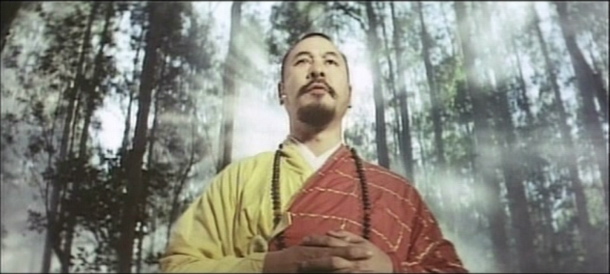| Action
Adventure Reviews
|
A Touch of Zen, 1969. Directed by King Hu.
Ying Bai, Billy Chan, Ping-Yu Chan.
Without meaning any undue hyperbole, King Hu's A Touch of Zen is the 2001: A Space Odyssey of martial arts movies. Oh, its plot is familiar enough to anyone who cares about such things: beautiful princess on the run from her enemies seeks the help of a young man who has never had an adventure in his life. Soon she's joined by her one of her retainers and they contrive to lay a trap for her pursuers...yada, yada, yada. If you've seen Star Wars, or better still, if you've seen Kurosawa's The Hidden Fortress, you know this story. But the story, as it turns out, is only the beginning. The movie begins with an extended prelude of nature shots. The first image in the film is a spiderweb, as it so happens, which is emblematic of the plot of the movie in the same way the opening shot of The Wild Bunch is as emblematic of THAT movie. Then slowly, the works of man are revealed, and then the characters, and then the story. It's fully forty-five minutes into the film before there's any martial arts action at all, which will try the patience of some viewers, but there's always something going on on-screen. Hu isn't interested in action as an end in and of itself, per se, so much as he is interested in contemplating the place of action, including its consequences, in the world itself. This is a long movie at three hours--its original cut, now lost, ran some seven hours--and Hu is in no hurry to get where he's going. The structure of the film consists of three acts. In the first, we have superstition and ignorance, as our young hero contrives to frighten his enemies with tales of a haunted temple. In the second, we have the worldly realm of politics and war, as our heroes become embroiled in a broader web of feint and counter-feint. In the final section, we find enlightenment, as the various threads of the plot run afoul of the Buddah himself. The final act of the movie pitches everything that came before it into a quest for our Buddah nature, and when the Abbot of the monks who figure into this part of the movie stares down the characters he encounters, he has the force of the sun behind his gaze.
King Hu was one of the pioneers of the martial arts movie and his style of action filmmaking here mimics his theme. He eschews the wire work that typifies later films, preferring to stage his action scenes with flash cuts and eliptical shot compositions that turn these sequences into koans: we are shown the overall shape of a thing, but we are left to fill in the negative space ourselves as a zen excercise. As a purely visual construct, the movie is striking (Tai Seng's DVD of the movie, though watchable, is not a very good transfer, though there may not be adequate source materials for a good version). Two recent wu xia films--Crouching Tiger, Hidden Dragon and The House of Flying Daggers--take on Hu's center-piece battle in a bamboo forest, though neither film takes Hu's style as their own (in spite of his filmmaking technique, the action choreography in Hu's films is still rooted in the stylized action of Peking Opera, a style that has mutated beyond recognition in the decades since). This is an ambitious film, one that belies the reputation of the kung fu movie as empty spectacle. If one likes movies that challenge the mind as well as pump the adrenalin, this is a movie that will do both. Mind you, it's not a difficult movie, as some "art" movies are difficult, but it is just as complex.
Originally written in July of 2006, revised 9/19/08
|
